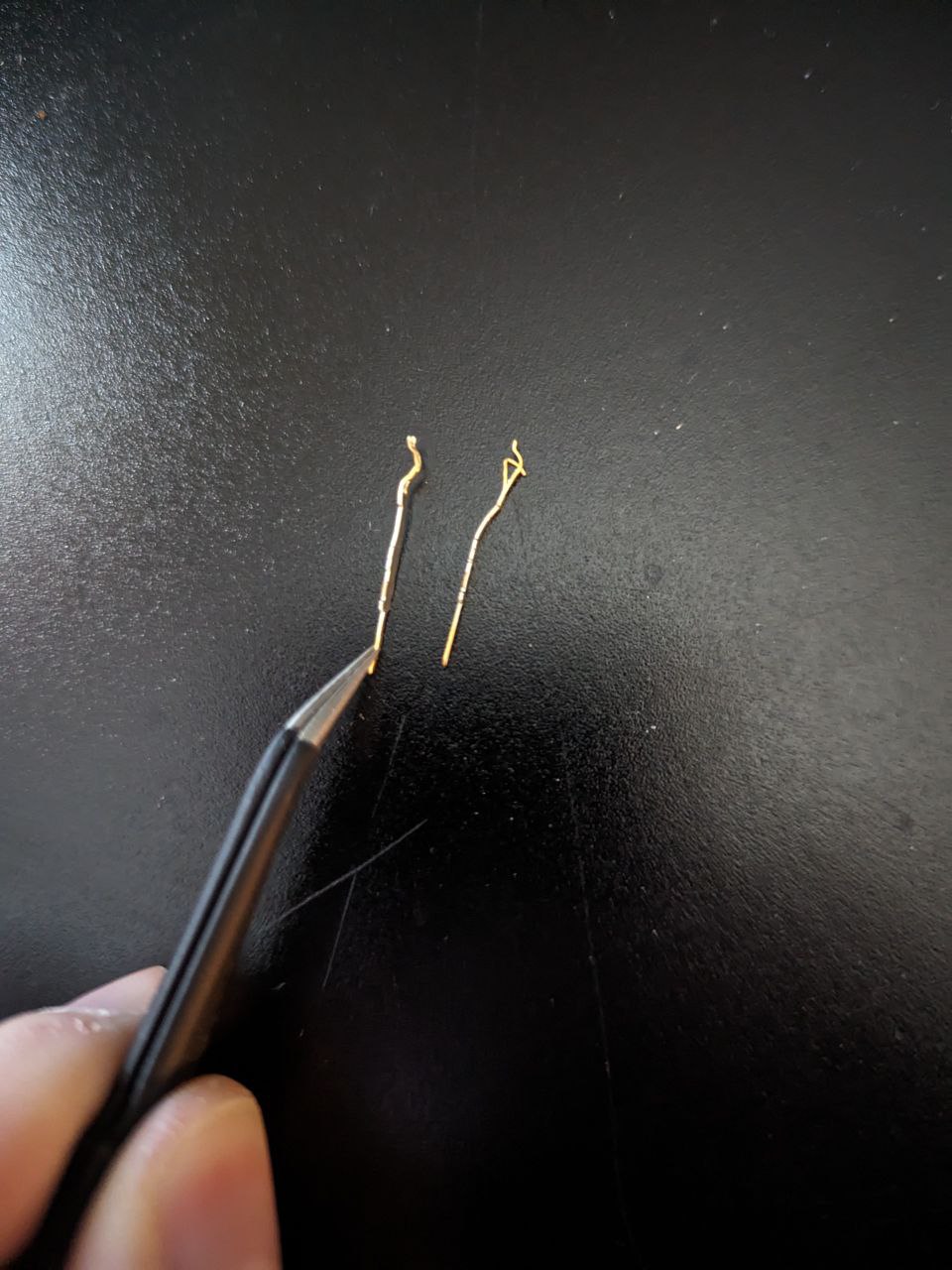
Title: Nintendo 64 Cartridge Slot Pins
Classification: Machine Part (partially broken)
Date obtained: March 11th, 2024
Description: these here are a set of two pins from my Nintendo 64's cartridge slot. but the pins themselves aren't the interesting part. well.. they kind of are. you see, i got an N64 for christmas in 2022, and while i was having a ton of fun with it, i couldn't help but notice that... certain games weren't saving. this is an interesting topic, because the N64 has a weirdly large amount of ways to save. there's battery saves, which use a battery in the cartridge to keep ram in memory even when the game isn't running. this is the most rudimentary way to do this, but it also really sucks, as most classic pokemon players know. those batteries have a habit of, you know, running out of juice, as batteries tend to do, so they're not ideal. (its unfortunate, because one of my favorite n64 games, 1080 Snowboarding, is cursed to use this method... meaning all my times are gonna get wiped some day. that stings.) then there's using the Controller Pak, a little memory card you plug into your controller. a large majority of N64 games not made by nintendo use this, and it's a decent way of saving. the original Controller Pak uses a battery as well, but thanks to a little gem called the Forever Pak 64, it can be circumvented and swapped out for a flash memory alternative. speaking of flash memory, surprisingly, some n64 games actually use this! it's extremely rare and only used for a handful of games, but it's pretty cool that its here at all. which leaves us with the last option... EEPROM. this is a type of non-volatile memory, and in most N64 games it only can store about 4 Kilobits. which... is not very much. that's why its usually used for games that don't need to store super complicated types of data. take Mario 64 for example, that only needs to keep track of which power stars you've collected and your high scores. that's only like, a handful of numbers. compare that to Pokemon Stadium, which uses flash memory, and for good reason. it has to store a LOT more data, since you can record your pokemon into that game. there's actually an alternate variant of EEPROM saving that stores up to 16 Kilobits, but it's only used by a small handful of games. it seems Rare was a big fan of 16 Kilobit EEPROM, since they used it in four of their N64 games. (by the way, i got a lot of this info from micro-64.com, they were a huge help in my research for this bit.)
so why am i telling you all of this? well, it's because for some reason, my christmas N64 wouldn't save with certain games. we couldn't figure out why for the longest time, it felt completely random whether or not it would save, and it was totally up to the whim of the game. it would save in Pokemon Stadium and 1080 Snowboarding, but wouldn't in Mario 64 or Glover. not only that, it also straight up wouldn't start certain games, such as Yoshi Story. i was totally stumped on this for the longest time, and just accepted my fate to never be able to save in some games. but back in March, i decided enough was enough. i was gonna figure out how to get this damn N64 to save if it was the last thing i did. so i took it apart and messed around with the cartridge slot for a while, trying to see what was wrong. well, a while ago, my roommmate pointed out to me that one of the pins in the cart slot seemed to be kinda messed up, and sure enough upon taking it apart there was a pin that was super bent out of shape. (pictured on the right in the image above) we weren't really sure what to do, and we looked up some schematics for the slot. turns out, the pin that was fucked up just so happened to be the pin that handles EEPROM read and write. that would explain why some games would save, but others wouldn't. another thing we noticed when looking at that schematic was that some of the pins were for ground, and weren't totally necessary. and so, in potentially the single greatest idea i think i've ever had, i ripped out the broken pin, ripped out one of the ground pins, and shoved the ground pin where the EEPROM pin used to be. upon plugging everything back into place, we booted up Glover and finally saw the huge collection of saves that was supposed to be there this whole time. this was also probably the reason Yoshi Story wouldn't start no matter what i did, because that's a 16 Kilobit EEPROM game. this pin replacement is possibly the only time i'll ever do anything cool in regards to tech hardware, but i'm still riding that high 6 months later.